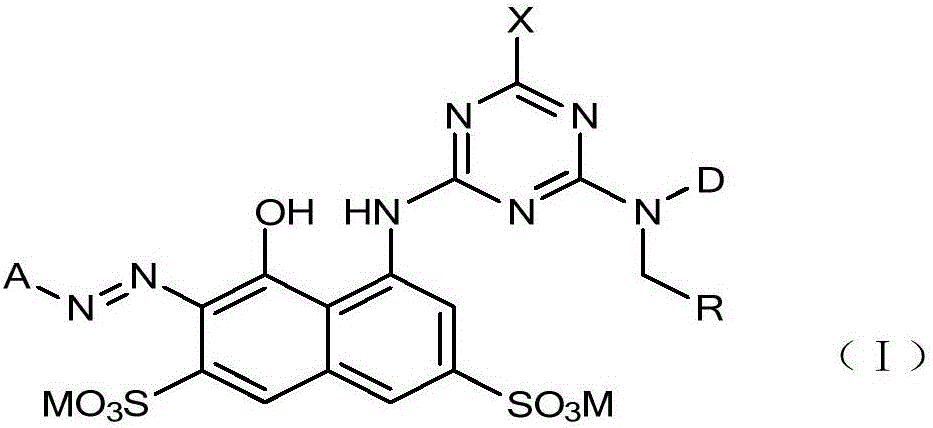Reactive red dye as well as preparation and application thereof
A technology of reactive red dye and condensation reaction, applied in reactive dye, reactive red dye and its preparation method and in the application field of cotton fiber printing and dyeing, can solve the problems of increasing dye cost and waste of active groups
- Summary
- Abstract
- Description
- Claims
- Application Information
AI Technical Summary
Problems solved by technology
Method used
Image
Examples
Embodiment 1
[0050] Embodiment 1: the preparation of formula (I-1) compound
[0051] (1) Diazo coupling reaction
[0052]In a 250ml beaker, add 20 parts (parts by mass) of ice, 24.3 parts of 30% hydrochloric acid, 28.1 parts of meta-ester, ice grinding and beating for 30 minutes, slowly add 6.97 parts of sodium nitrite to generate diazonium salt, wait until sodium nitrite is completely added Stir for 1 hour, and use sulfamic acid to eliminate the slight excess of sodium nitrite; slowly add the diazonium salt dropwise to 31.9 parts of H acid, adjust the pH to 5.5-8.0 with baking soda while adding it, and continue the reaction for 2 hours after the addition is complete. The diazonium salt completely disappeared while maintaining the system temperature at 0-10°C.
[0053]
[0054] (2) Primary condensation of coupling components and cyanuric fluoride
[0055] In a 1000ml flask, add 50 parts (parts by mass) of ice to the coupling liquid, then dropwise add 13.5 parts (percentage) of cyanuri...
Embodiment 2
[0066] Embodiment 2: the preparation of formula (I-2) compound
[0067] (1) Diazo coupling reaction
[0068] In a 250ml beaker, add 20 parts of ice, 24.3 parts of 30% hydrochloric acid, 28.1 parts of para-ester, ice grinding and beating for 30 minutes, slowly add 6.97 parts of sodium nitrite to generate diazonium salt, stir for 1 hour after the sodium nitrite is completely added, and use Sulfamic acid eliminates slightly excess sodium nitrite; slowly add the diazonium salt to 31.9 parts of H acid, and adjust the pH to 5.5-8.0 with baking soda while adding, continue to react for 2 hours after the addition, and the diazonium salt is completely disappear while maintaining the system temperature at 0-10°C.
[0069]
[0070] (2) Primary condensation of coupling components and cyanuric fluoride
[0071] In a 1000ml flask, add 50 parts (parts by mass) of ice to the coupling liquid, then dropwise add 13.5 parts (percentage) of cyanuric fluoride to it, adjust pH=3.5-5.0 with bakin...
Embodiment 3
[0082] Embodiment 3: the preparation of formula (I-3) compound
[0083] (1) Diazo coupling reaction
[0084] In a 250ml beaker, add 20 parts of ice, 24.3 parts of 30% hydrochloric acid, 35.2 parts of 2-[2-(3-aminobenzamido) ethyl sulfone] ethanol sulfate, ice grinding and beating for 30min, 6.97 parts of sodium nitrite Add slowly to generate diazonium salt, stir for 1 hour after sodium nitrite is completely added, and use sulfamic acid to eliminate the slight excess of sodium nitrite; slowly add diazonium salt to 31.9 parts of H acid, and use a small amount of water while adding Adjust the pH to 5.5-8.0 with soda, continue to react for 2 hours after the addition, and the diazonium salt will disappear completely, while keeping the system temperature at 0-10°C.
[0085]
[0086] (2) Primary condensation of coupling components and cyanuric chloride
[0087] In a 1000ml flask, add 50 parts (parts by mass) of ice to the coupling feed solution, then add it to 18.5 parts (100 pe...
PUM
 Login to View More
Login to View More Abstract
Description
Claims
Application Information
 Login to View More
Login to View More - R&D
- Intellectual Property
- Life Sciences
- Materials
- Tech Scout
- Unparalleled Data Quality
- Higher Quality Content
- 60% Fewer Hallucinations
Browse by: Latest US Patents, China's latest patents, Technical Efficacy Thesaurus, Application Domain, Technology Topic, Popular Technical Reports.
© 2025 PatSnap. All rights reserved.Legal|Privacy policy|Modern Slavery Act Transparency Statement|Sitemap|About US| Contact US: help@patsnap.com



